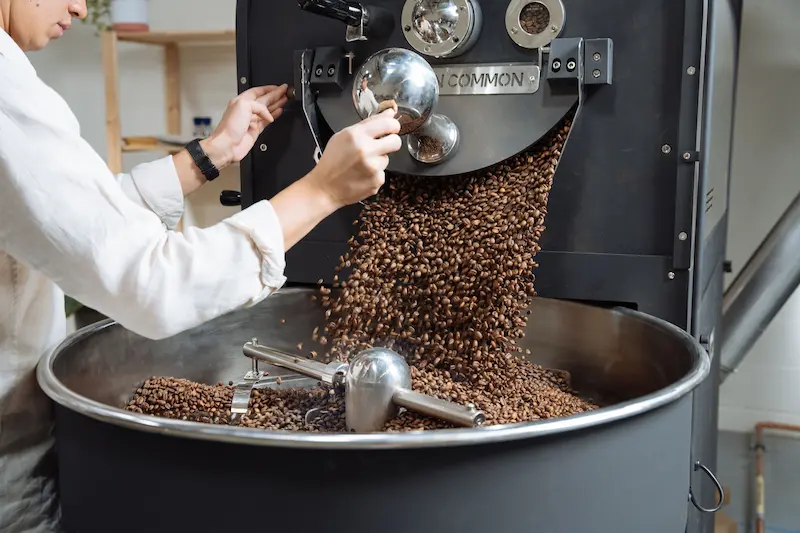What’s the story behind the coffee culture in Australia? From the first bean landed with the European settlers to the present-day café society, the history of coffee in Australia reflects a nation’s evolving tastes and social changes. Our dive into this history looks at the establishment of coffee palaces, the rise of the espresso bar, and Australia’s unique coffee innovations, laying a path of discovery for readers seeking to understand how coffee became a staple of Australian life. Additionally, coffee has also had a dramatic effect on office environments. Employees now have an expectation for office coffee machines.
Key Takeaways
- Australian coffee culture traces back to 1788 and evolved with the 1870s coffee palaces, then dramatically transformed with the mid-1900s Italian influence and espresso machines.
- Australian cafes offer unique and diverse experiences, adapting to consumer demands like alternative milk options and fostering a love for home-brewing with advanced coffee machines.
- Sustainability is becoming a central theme in Australia’s evolving coffee scene, amid challenges like climate change impacting coffee production.
Early Beginnings: The Arrival of Coffee in Australia
The aroma of coffee first wafted through Australia with the arrival of the First Fleet in 1788, brought by European settlers. This signalled the genesis of the coffee industry in the country. Fast forward to the 1870s, Australia saw the rise of coffee palaces, inspired by the glitz and glamour of Parisian coffee shops, which helped to popularise coffee.
These coffee palaces were fancy, alcohol-free zones where Australians could socialise and enjoy their coffee in style. At this time, espresso coffee was still a distant concept, but these palaces laid the groundwork for the future coffee culture. The Temperance Movement played a significant role too, promoting coffee as an alternative to alcohol, thus further elevating the status of coffee.
The Rise of Coffee Culture: Italian Influence and Espresso Machines
The mid-1900s saw Italian immigrants leaving a deep imprint on Australia’s coffee scene. They introduced an espresso culture, forever transforming the Australian coffee landscape. With the introduction of the first commercial espresso machine in 1928, Australians experienced high-quality coffee, which piqued their interest in fresh coffee beans and the intricacies of espresso.
The influence of the Italian café culture didn’t just stop at espresso machines. The imported European café culture significantly contributed to the formation of Australia’s own café and barista culture. These espresso machines, synonymous with Italy’s coffee history, played a vital role in shaping Australia’s specialty coffee culture, a legacy that endures today.
From Coffee Houses to Modern Cafés: Transformation of the Australian Coffee Scene
During the 1950s, espresso machines began to proliferate in Melbourne and Sydney, heralding the advent of Italian coffee houses and marking a significant shift in Australia’s coffee culture. Influenced by evolving cultural preferences, societal shifts, and gentrification in inner-city suburbs, these traditional coffee houses gradually evolved into contemporary cafes.
Such transformations have rendered the Australian café culture both diverse and intriguing. Today, consumers are not just looking for a caffeine fix but a mood-enhancing experience. The demand for alternative milk options and the rise of health-conscious consumers are shaping the modern Australian café scene.
The Australian Coffee Lexicon: Unique Terminology and Preferences
Australia boasts a coffee lexicon as unique as the leap of a kangaroo. From ‘flat white’ to ‘long black’, these terms have come to define the Australian coffee culture. Here are some popular coffee terms in Australia:
- ‘Flat white’: started in the 80s as a coffee with double espresso and steamed milk with a bit of foam
- ‘Long black’: a double shot of espresso poured over hot water
- ‘Short black’: a single shot of espresso
This avid interest in coffee and its subtle complexities speaks volumes about Australian coffee enthusiasts and their passion for their daily brew. Espresso-based drinks like:
- Mocha
- Short Black
- Long Black
- Flat White
- Cappuccino
- Piccolo
- Latte
- Macchiato
remain firm favourites. The customisation of coffee, offering a plethora of espresso-based and milk-based options, is also a significant element of the Australian coffee culture.
Melbourne: The Heart of Australian Coffee Culture
A moment of appreciation is warranted for Melbourne, Australia’s coffee capital. With its rich history and the influence of Italian immigrants after World War II, Melbourne has been instrumental to the coffee culture in Australia. From its bustling city centre to its charming laneways, you’ll find a coffee shop at every corner, each with its unique style and flavour.
The baristas play a pivotal role in Melbourne’s coffee culture. They are the custodians of the city’s coffee scene, turning coffee beans into an art form. Their skill set, enthusiasm, and expertise have been instrumental in establishing Melbourne’s reputation as the epicentre of Australian coffee culture.
Cold Brews and Iced Coffee: Adapting to Australia’s Climate
In Australia’s sun-drenched landscape, iced coffee and cold brews offer a refreshing counter to the warm weather. Ranging from traditional iced coffee to innovative cold brews, these beverages serve as a popular choice for Australians seeking a chilled caffeine boost. Some even include indulgent ingredients like ice cream, making them the perfect summer treat.
The presence of cold brew coffee in Australia dates back to the mid-1800s, owing its origins to Dutch or Japanese culture. Today, it’s a staple on the menu of Australian coffee shops, offering a unique and refreshing option for coffee lovers.
Brewing Quality Coffee at Home: A Growing Trend
Home brewing of barista-quality coffee is a burgeoning trend in Australia. With a specialty café cup costing around $4.50, many Australians are taking their coffee routine into their own hands to save some cash. The availability of advanced coffee machines like the Morning Machine and Breville Barista Express has further fuelled this trend, allowing coffee lovers to enjoy café-quality coffee in the comfort of their homes.
In the pursuit of brewing premium coffee at home, Australians are becoming increasingly selective about their choice of coffee beans, water, and brewing techniques. The emphasis is on using high-quality, freshly roasted beans, grinding them just before brewing and using filtered water for the best results.
With home coffee brewing projected to grow by about 5.67% annually throughout the forecast period, it’s clear that more Australians will continue savouring their ideal cuppa at home.
Sourcing Fresh Coffee Beans: Where to Buy and What to Look For
Sourcing fresh coffee beans is pivotal to brewing the perfect coffee at home. Australians can buy fresh coffee beans from local coffee shops and roasters, including:
- Arabica
- Robusta
- Liberica
- Excelsa
The roast of the beans also significantly affects the flavour of the coffee, with light roast lending a more acidic and fruity taste, while a dark roast offers a bitter, smoky flavour.
In Australia, coffee beans, which are harvested from the coffee plant, are usually packaged in special bags that feature degassing valves and resealable closures to maintain freshness. Eco-conscious options are also available, with recyclable and compostable packaging materials being increasingly used.
Beyond Coffee: The Diversity of Australian Café Offerings
Australian cafes serve more than merely coffee. For those in the mood for something different, cafés serve an array of other beverages ranging from bubble tea, chai, and matcha to shakes, juices, and smoothies. Tea lovers can enjoy traditional English Breakfast, Earl Grey, Chamomile, and even unique Aussie-grown black tea and Eucalyptus-flavoured teas.
For a refreshing break, Australian cafés also offer a variety of smoothies, from health-focused superfood blends to indulgent flavours like Snickers and Pina Colada. And for those nostalgic for a classic soda, Aussie cafés have got you covered with favourites like Coke, Sprite, Fanta, and the delightful Kirks Creaming Soda.
The Future of Coffee Culture in Australia
Looking to the future, Australia’s coffee culture is set to continue its evolution. One of the key focus areas is sustainability, with efforts to make coffee farming more eco-friendly and reduce the use of single-use plastics. With coffee becoming a daily essential, Australians are embracing innovative trends such as mood-enhancing coffee varieties and the growing popularity of alternative milks.
However, the future also brings challenges. Climate change poses a significant threat to coffee production in Australia and worldwide, affecting the growth of coffee beans and disrupting the weather patterns necessary for their growth. Despite these challenges, Australians stay devoted to their coffee culture, prioritising sustainability, experimenting with novel brewing methods, and ensuring that each cup of coffee boasts its unique flavour.
Summary
From the arrival of coffee with the First Fleet in 1788 to the innovative café culture of today, Australian coffee culture is a rich tapestry woven with history, innovation, and a love for quality coffee. As we continue to embrace new trends, focus on sustainability, and honour our unique coffee heritage, the future of Australian coffee culture looks as inviting as a freshly brewed cup of coffee. So, here’s to the next extraordinary chapter in our coffee journey.
Frequently Asked Questions
When did coffee culture start in Australia?
Coffee culture in Australia started to emerge in the 19th century, initially catering to the wealthy, but it significantly developed after the post-World War II Italian migration, shaping the coffee scene we see today.
What coffee was invented in Australia?
The flat white coffee was invented in Australia in the 1980s or 1990s, with both Australia and New Zealand claiming its invention. It is a drink made from espresso and creamy steamed milk, famous for its distinctive velvety layer of microfoam on top.
What did Australians drink before espresso coffees?
Before espresso coffees, Australians drank tea as their primary beverage. The popularity of filter coffee in Sydney lasted until the arrival of the first commercial espresso machine in 1928.
How did Melbourne become the coffee capital of Australia?
Melbourne became the coffee capital of Australia due to its rich history and the influence of Italian immigrants after World War II.
How is home coffee brewing becoming a trend in Australia?
Home coffee brewing is becoming a trend in Australia because many people are choosing to save money by making their own café-quality coffee with advanced coffee machines. It’s a more affordable option compared to buying a $4.50 cup at a specialty café.


